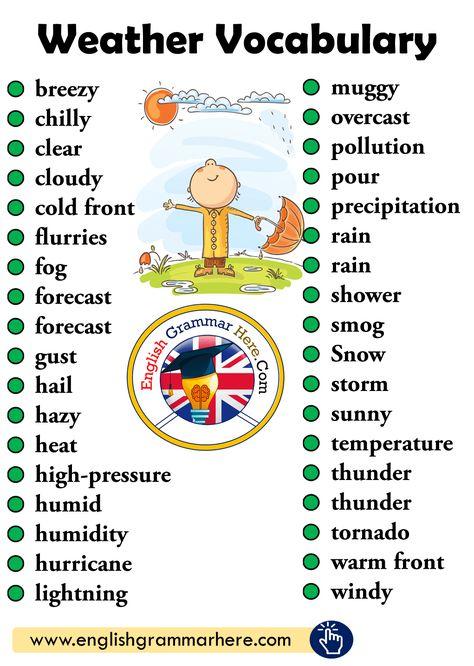Teaching weather vocabulary early on in an English course is a great idea because it is something that the students can practice on a daily basis. Especially during daily warm ups, teachers can always ask about the weather and weather vocabulary comes in handy during other activities too.

Teaching Weather: Step By Step Guide
1. Warm up
During your usual warm up, try and get the students talking about the seasons. Then, ask students what season they like best and see if anyone can explain why. This is a great way to elicit some of the weather vocabulary you plan to practice during the lesson. When certain vocabulary words come up, write them on the board. Depending on the level of your students, you can also talk about different activities people do during particular seasons and why some of them, such as skiing, cannot be done throughout the whole.
2. Introduce
During your warm-up activity, you should have been able to build a vocabulary list on the board, which will make it easier to introduce the new vocabulary. Another great way to introduce your weather related vocabulary is by using weather flashcards. Some basic words you may want to include are sunny, cloudy, raining, snowing, hot and cold. To practice, drill these new words using repetition and then call on students to say them one by one.
3. Practice
Once the students have had some practice pronouncing the new weather vocabulary words, have a short activity to give them some further practice. For example, you can give each student a small version of one of the flashcards. Then, have them arrange their chairs in a circle and remove one chair. The student in the middle of the circlee can read their card and the students with the same card should remain seated while the other students have to change seats. This way, the word being said always changes and no one will have to sit for too long. This activity works not only for young students but also teenagers or adults. One thing to keep in mind when making the mini flashcards is to use the same images that you used on the large flashcards to avoid confusion and help your students memorize the words by associating them with particular images.
4. Introduce
Next, ask your students “How’s the weather today?”, introducing the structure for the question. When the students reply “Cloudy!” you can say “That’s right! It’s cloudy.” modeling the sentence structure you want them to learn. Use flashcards to have students practice the sentence structure using different weather words. If you want students to say “It’s raining.” the rain flashcard should say raining on it. You want to give students as much practice as possible with the form of the word they will need for the lesson before moving on to having them independently use different forms of the word.
5. Practice
For the practice, your students can use the same flashcards they had earlier or maybe switch with another student for the next activity. Ask your students to walk around the classroom asking the question “How’s the weather?” and answering the question based on the word on their card. The students have to find someone to say each weather word listed on the worksheet and get signatures (or stickers as a reward!) from the students they talk to.
6. Review
For a review activity, you may want to include another recent topic, for example, days of the week into your weather lesson. One great way to do this is by creating an activity around weather forecasts. The students can work with a partner with each student having a weekly weather forecast with some blanks. Next, the students talk to their partners about the weather on different days and successfully complete their weekly forecast worksheet. It is important for the students to take turns both asking and answering questions about the weather. For example, one student asks “How’s the weather on Monday?” while the other student responds “It’s sunny.” or “On Monday, it’s sunny.”
Weather is one of those topics that ESL students can talk about a lot as it changes on a daily basis. Give your students lots of opportunities to use weather related vocabulary throughout the class to keep these words fresh in their minds. See our Weather Vocabulary list above for more ideas.
Are you interested in teaching English as a foreign language?
Get your TEFL certification with ITTT.
Register now & get certified to teach english abroad!


